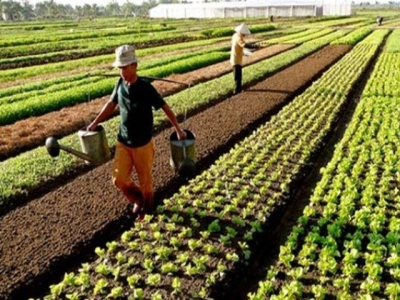Policy obstacles hinder the development of agricultural land

Slow land accumulation and outdated policies are hindering the development of Việt Nam’s agricultural land market. — Photo nhandan
HÀ NỘI — Land is considered the most important aspect of agricultural production. However, slow land accumulation and policy obstacles are hindering the development of the agricultural land market in Việt Nam.
Trần Thị Thanh Nhàn, an expert from the Institute of Policy and Strategy for Agriculture and Rural Development (IPSARD), said the amount of agricultural land per capita in Việt Nam was very small, just 0.07 hectares per person, much lower than that of Thailand (0.27ha per person), according to the World Development Indicators.
Over 70 per cent of the country’s agricultural plots were less than 0.5ha.
“This is the biggest obstacle to the development of agriculture which increases costs for leasing and land transfer,” Nhàn said at a consultation workshop on challenges to agricultural land market development in Việt Nam in Hà Nội on Wednesday.
Despite the fact that localities had collected statistics on different kinds of plants and soils, there still existed areas of industrial crops and fruit cultivation that encroached on forest land, affecting the growth of the land market.
The number of households that took part in purchasing or transferring agricultural land use rights accounted for 10 per cent of the total number, Nhàn said, citing surveys conducted on 3,700 households in 12 provinces and cities from 2012 to 2016.
She attributed the low rate to a number of obstacles related to government policies. For example, Article 179 of the 2013 Land Law said the transfer of land use rights must be implemented between farmers residing in the same commune, ward or town.
Among three forms of land use rights transfers, the form that allows enterprises to lease agricultural land from farmers is popular. However, she said, enterprises face difficulties because while there are a lot of farmers, land plots were scattered, resulting in high costs.
It is not easy for them to lease land from the State as the land fund is becoming scarce.
Nhàn said that in some localities including Hà Nam and Lâm Đồng provinces, the local authorities leased agricultural land of farmers and then re-leased it to enterprises. But it was difficult to apply this model on a large scale due to a lack of regulations.
Addressing the workshop, Ngô Mạnh Ngọc, deputy director of Hà Nam Province Agriculture and Rural Development, said many households worried they would lose their land or would not be permitted to cultivate it after the lease expired.
The Land Law did not state that local authorities could sign leases with residents or lease land to enterprises before obtaining compensation for land clearance. He also said that, under the Budget Law, local authorities were not allowed to pay land lease fees in advance and get refunds from enterprises later.
To facilitate land market development, Nguyễn Đỗ Anh Tuấn, director of IPSARD, said it was necessary to attach its efficiency to job creation in rural areas.
He also said the establishment of a comprehensive land database and re-granting of land use right certificates was a must.
Participants at the workshop agreed that the State should play a vital role in bringing about economic efficiency of land and that it was in harmony with sustainable development and socio-economic stability.
Có thể bạn quan tâm
 Bac Giang maintains 28,000 hectares of lychee cultivation in 2019
Bac Giang maintains 28,000 hectares of lychee cultivation in 2019 The plan of lychee production in 2019, covering 28,000 hectares with the expected output of 6 tonnes per hectare and total productivity of 168,000 tonnes
 An 8X guy started up with the model of clean food production
An 8X guy started up with the model of clean food production An 8X guy Bui Huy Chuong, 1984, in Minh Son village, Yen Tri commune (Yen Thuy) started to make his passion of producing clean food to provide for consumers.
 MARD promotes development of geographical indications and trademark of agricultural product
MARD promotes development of geographical indications and trademark of agricultural product MARD as requested specialized agencies to develop trademarks for major items, including: rice, coffee, Tra fish and shrimp, and develop geographical indications